Inter Milan will be looking to bounce back to the top of Serie A after narrowly missing out on winning back-to-back league titles. The squad that won the league in 2021 was heavily decimated due to the impacts of the pandemic, with owners needing to sell their key players in order to stay afloat.
Romelu Lukaku and Achraf Hakimi both left for big money, only a couple of years after arriving, while old head coach Antonio Conte also left due to the destruction of the side he built. After Lukaku’s spell at Chelsea didn’t work out, he is back at Inter to help them yet again become the best club in Italian football.
On the other hand, Lecce have arrived as the champions of Serie B and will be looking for survival in a league which has a large number of quality teams. Lecce have made 13 signings in what is a big effort to try and survive in one of the more challenging leagues around Europe.
This tactical analysis will delve into the tactics used by Internazionale. The analysis will display the problems that Lecce faced during their match, and why this Inter performance can provide an optimistic outlook for the season ahead.
Lineups and formations
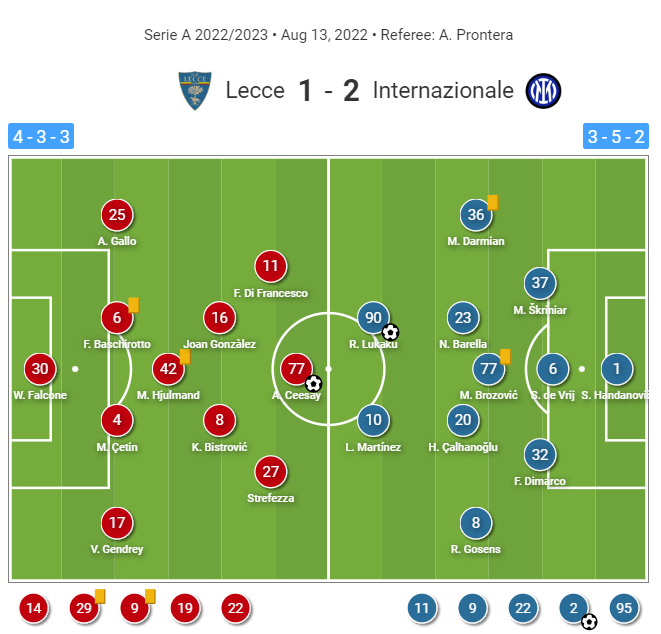
Inter Milan came into this game with one new signing in Romelu Lukaku, whilst Gosens also made his way into the eleven after a season riddled with injuries last year. They stick with the 3-5-2 that has worked well for Inzaghi and the same formation that won Inter the Scudetto in 2021 with. The rest of the starting squad is the same as the one that was so close to winning the league last year, after narrowly losing it to AC Milan.
New signings Onana and Mkhitaryan both are being slowly eased into the new side while Lukaku already is familiar with the majority of his teammates, whom he played with only two seasons ago.
It has been a busy window for Lecce, with only Strefezza, Gendfrey, Hjulmand and Gallow having played together last season. It will for sure take time for all the new signings to settle in, and work on their relationships with each other. The 4-3-3 is used by manager Marco Baroni, something which worked out well in Serie B.
Inter’s build-up
In the match, Inter had 69% possession, partly thanks to the good structure set up by Inzaghi. Another reason for the dominance of the ball was Lecce’s reluctance to press the Inter back line too often. On most occasions, Lecce were happy to sit back and let Inter have the ball in order to limit the space left behind in deeper areas. When Lecce did press, they would leave themselves open to ‘artificial transitions‘ where Inter played through the press, almost as if they were in an attacking transition even though they had control of the ball, rather than having just won it back.
The image below shows a perfect example of how Inter patiently played with the ball, in an attempt to lure the opposition players out of position and attack the space vacated. Pressing in a 4-3-3, the Lecce front three perfectly matched up with the Inter central defenders whilst the three midfielders matched up with Inters midfield three quite well.
Lecce’s problem was the lack of compactness in their block, with the spaces between the lines being too big. The back line of Lecce were anxious, with a lack of willingness to step up to intercept the ball. As a result, it was easier for the Inter Milan players to make off-the-ball runs into the massive spaces and receive the ball higher up the pitch. Calhanoglu and Barella would both drift into the spaces across the middle third, where they could turn with the ball and drive the team further up the pitch.
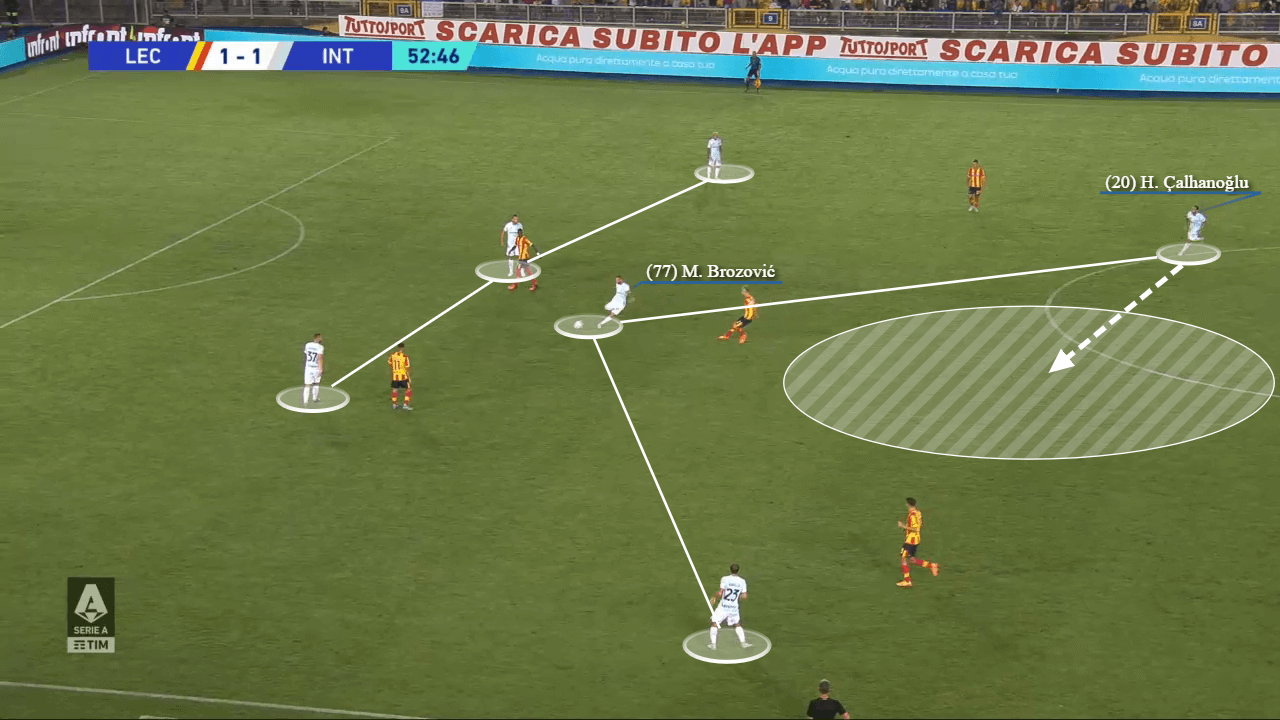
After the Lecce press would come in, where there was a 6v6 in the defensive half, it would result in a 4v4 in Lecce’s half. Not having the defensive overload would cause Lecce frequent problems, where each defender was left in a 1v1, which resulted in many problems for each individual in the back line who is weaker than the players in Inter’s attack qualitatively.
Another flaw Lecce faced was their narrow press, coupled with a lack of aggression from full-back, which resulted in the Inter wing backs having lots of space to receive the ball and ease the pressure off of the back line. The image below shows Inter Milan’s great movement in attack, where Martinez drifts out wide, which creates space ahead of Lukaku who can easily receive the pass and turn with the ball. The Martinez run drags the Lecce players out of the way, and Inter resorted back to old tricks where they trust in Lukaku’s immense strength and ability to hold the defender off, so they can retain possession in key areas further up front.
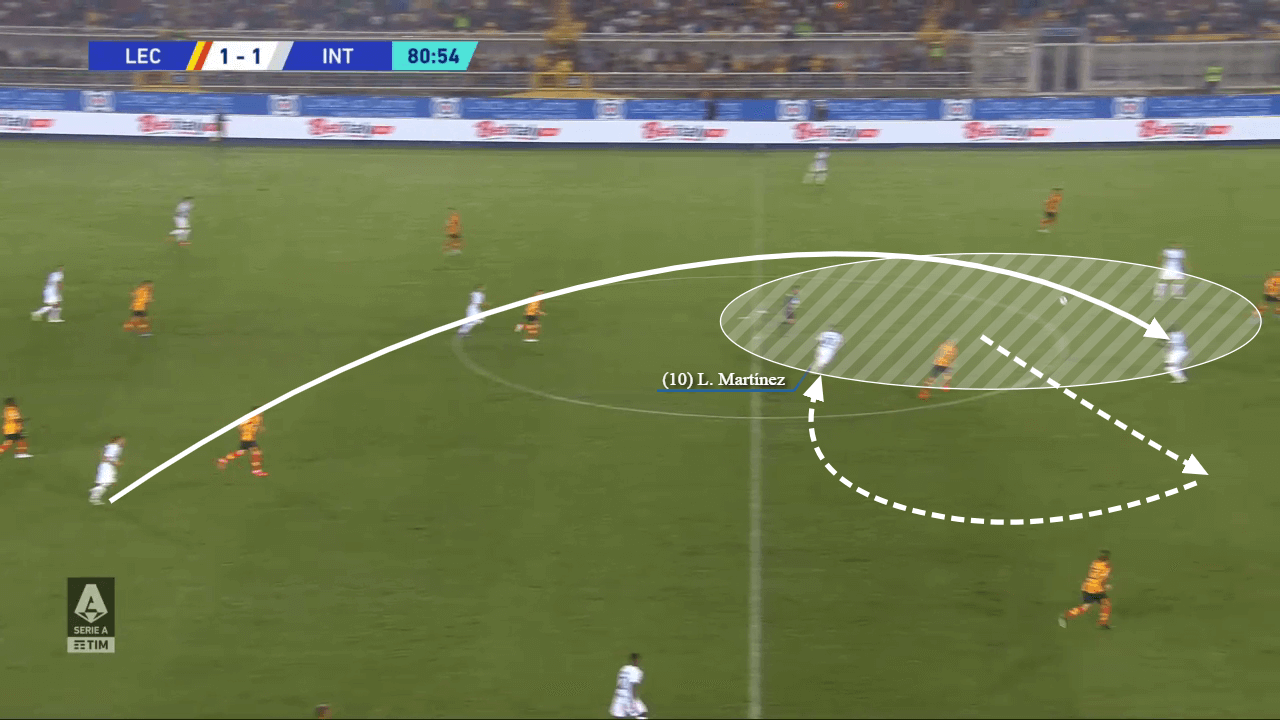
At times, when Lecce’s whole front three pressed the Inter backline, an Inter midfielder would drop into the defence to make a back four. This would help overload the frontline by creating a 4v3 for Inter’s defence, where the free defender can receive the ball and drive the team further up the pitch. The image below shows Barella dropping to make a back four, which results in a 4-2-4 build-up shape.
Whilst the midfield two may be overloaded, there are now many different passing lanes made available to any of the four outlets who are all on the last line of defence. This more direct approach helps Inter expose the high line where there are lots of runners running at the massive hole left behind by the defence.
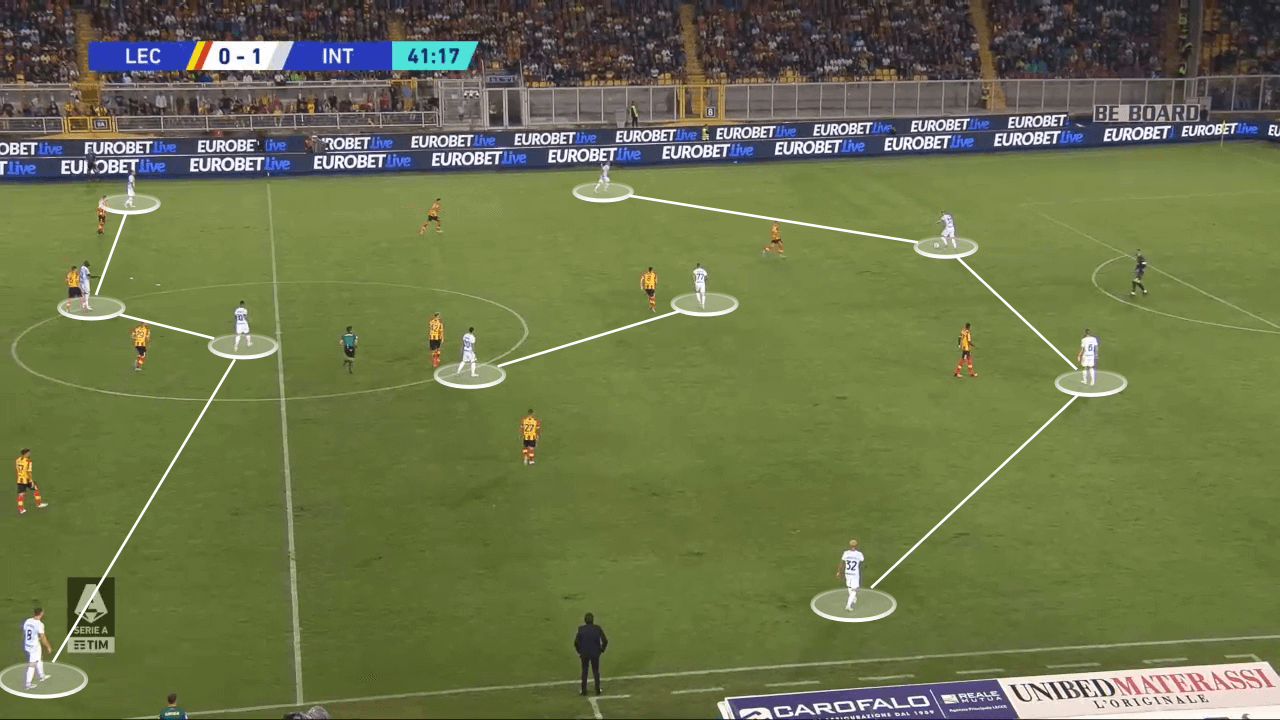
Danger from different zones
In the final third, Inter were as deadly and creative as ever, having created just over 2 xG. The return of Romelu Lukaku has made Inter more difficult to handle than in the previous season. Lukaku is the focal point who can hold the ball up, can create through passing combinations as well as be a chaotic figure when attacking the box.
The image below shows Lukaku’s ability to keep the defender away at a distance, and his technical ability to play a good pass in the gap for Barella to run on to. While Inter usually like to attack the flanks, Lecce became more used to defending wider, which opened up gaps in the middle of the pitch for the likes of Barella and Calhanoglu to exploit, with their late runs into the box.
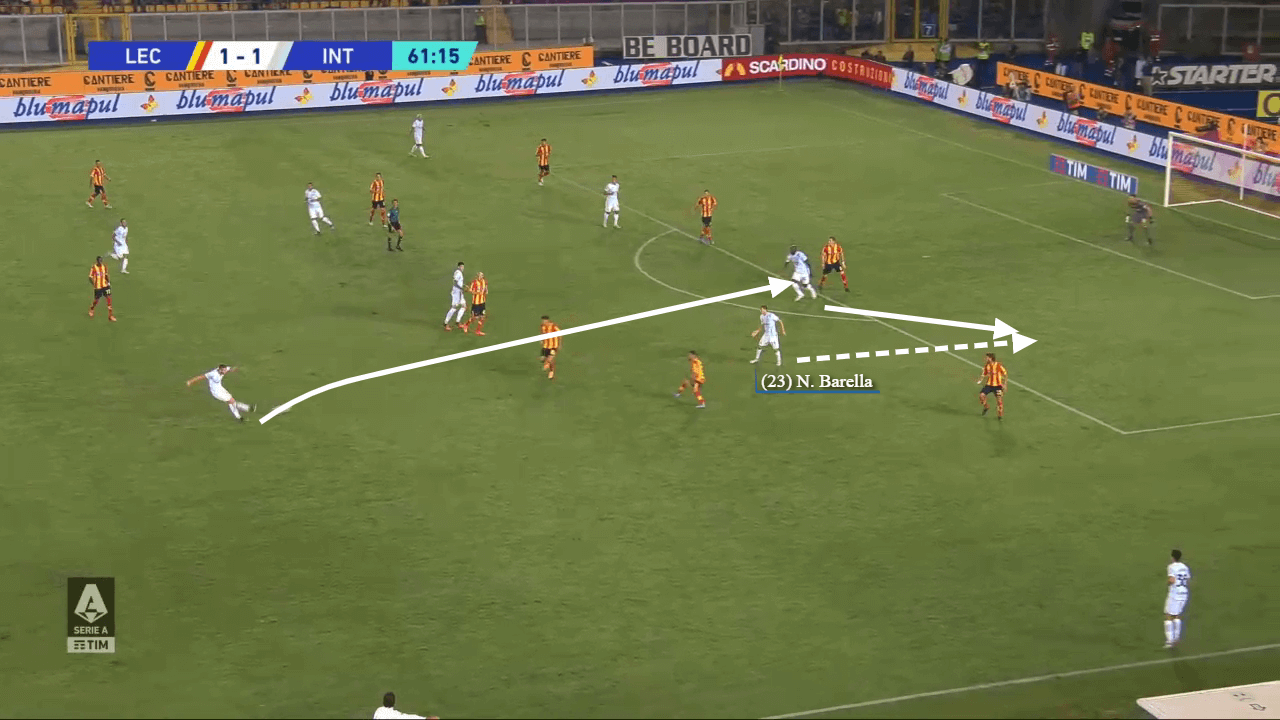
Inter’s preferred method of creating chances is to keep the ball in wide areas and use their wing-backs to make crosses to the back post. With the two strikers, two wingbacks and Barella attacking the box. Inter usually end up with a 5v4 at Lecce’s last line of defence, with the free player usually being the wing-back arriving on the edge of the box. The first goal Inter scored came as a result of a cross to the back post, with Darmian heading the ball across the goal for Lukaku to header it into an open net.
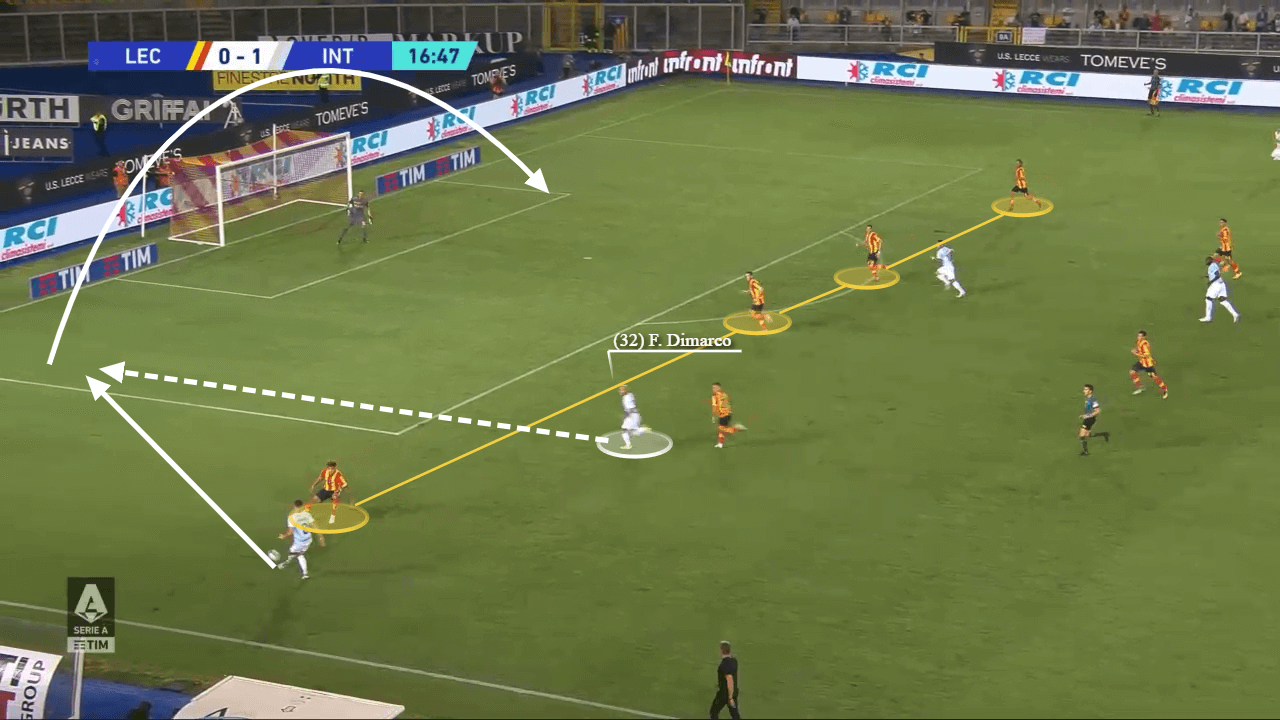
Dumfries’ impact
Denzel Dumfries was brought on in the 67th minute with the score still at 1-1, and his added athleticism and positional awareness changed the dynamics of Inter’s attack. Dumfries, compared to Darmian, is a much more powerful ball-carrier and cleaner striker of the ball. The endless runs Dumfries made at the opposition back line caused further problems for the Lecce defenders, and their inability to track the defenders well enough ended up creating more gaps for other Inter players.
The image underneath shows Dumfries’ darting run inside the pitch, which has dragged the left-back out of position. Martinez then attacks the space created and receives the ball with lots of time from which he plays a dangerous low cross across the face of the goal, although it doesn’t end up in the back of the net.
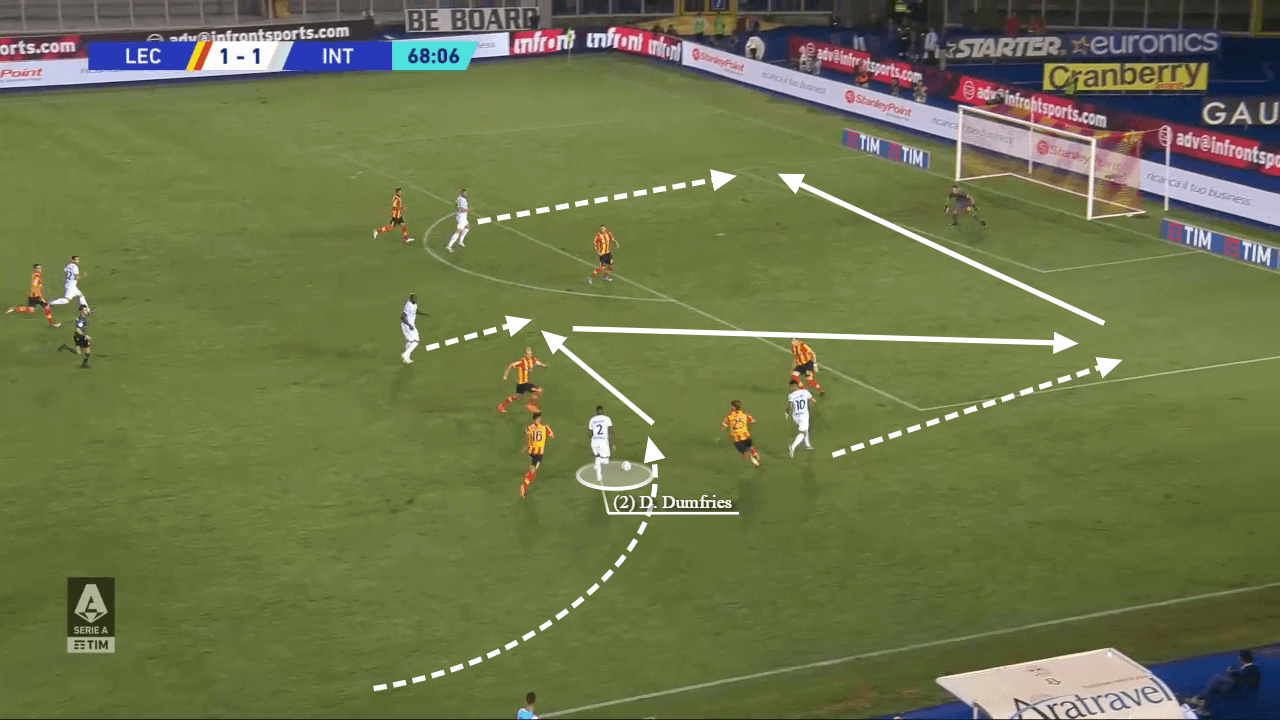
As well as being a good ball carrier and relentless runner, Dumfries also has the ability to attack the box with his strength in jumping over defenders and his ability to place shots in difficult areas. This image below shows Dumfries towering over the opposition defender, and placing the shot onto the post. While the shot may not have gone in, Dumfries instantly proved his offensive threat and provided the Lecce back line with one more problem to try and keep an eye on.
In the last minute of the match, Dumfries showed his superb ability to attack the box yet again, by scoring a goal from a corner after one of his teammates flicked it on towards the back post.
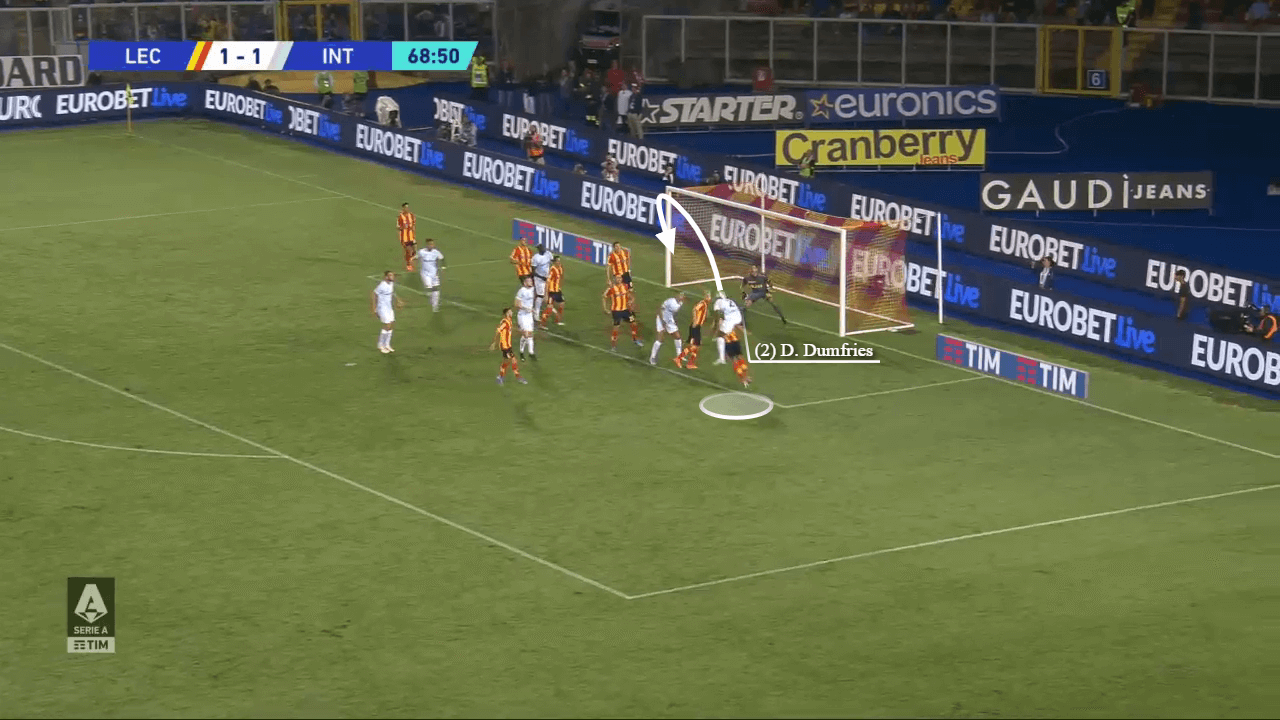
Dumfries also has the positional intelligence and discipline to retain the width in attack, where he can have space and time on the ball. In the picture below, Dumfries waits in a wide lane, where he has a great angle from which he can play a dangerous low cross towards Edin Dzeko, although the cross lacks a little bit of precision.
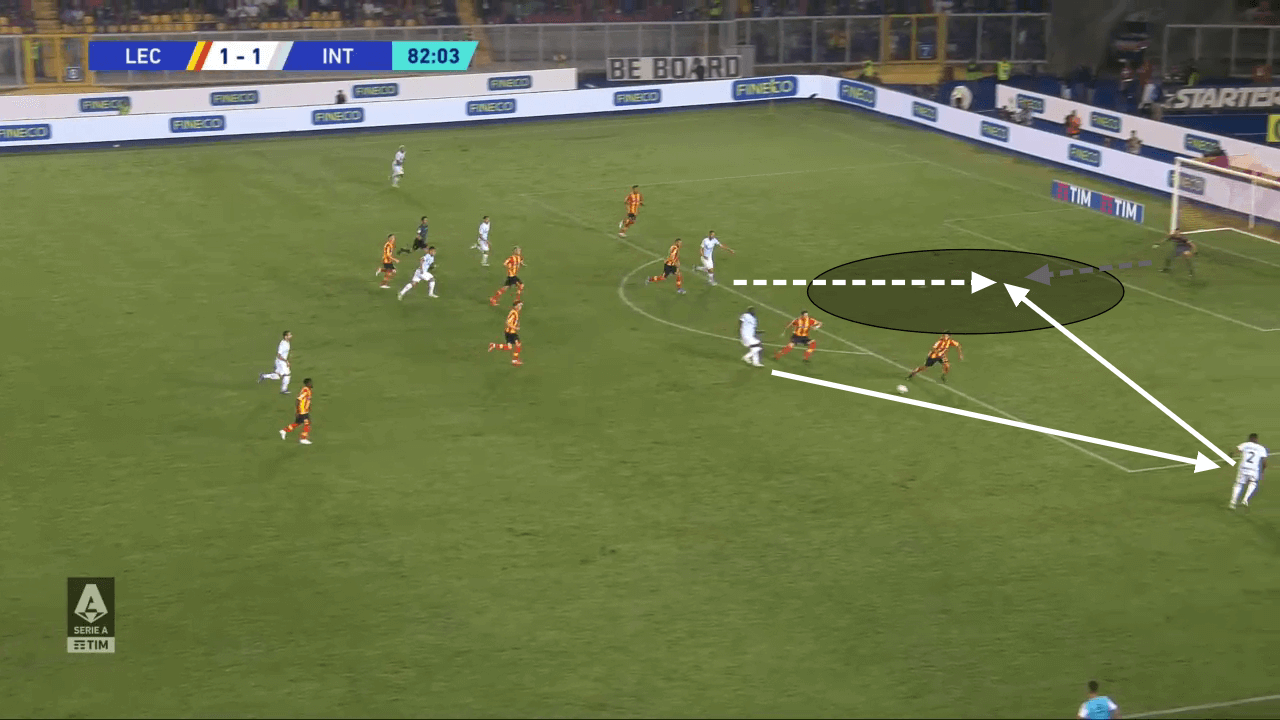
Conclusion
Internazionale have used this opening weekend to show the rest of their Serie A rivals that they mean business, although the win was slightly more difficult than expected. Inter had control for the majority of this match, but a lack of a cutting edge made it look like Inter struggled against the newly-promoted side.
As long as Inter keep producing this many chances week in and week out, they will be likely favourites to win most games and should be considered as favourites for the Serie A title, considering the firepower they have in attack, as well as the strong and reliable core of the team.






Comments